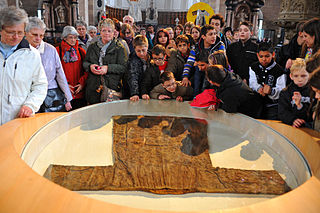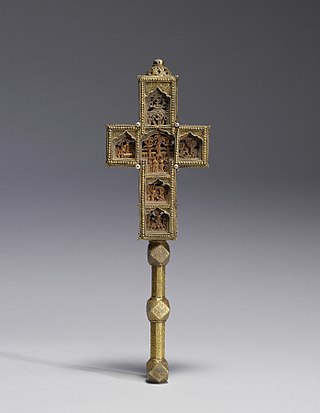
Flavia Julia Helena, also known as Helena of Constantinople and in Christianity as Saint Helena, was an Augusta of the Roman Empire and mother of Emperor Constantine the Great. She was born in the lower classes traditionally in the city of Drepanon, Bithynia, in Asia Minor, which was renamed Helenopolis in her honor, although several locations have been proposed for her birthplace and origin.

James the Just, or a variation of James, brother of the Lord, was, according to the New Testament, a brother of Jesus. He was the first leader of the Jerusalem Church of the Apostolic Age. Traditionally, it is believed he was martyred either in AD 62 by being stoned to death on the order of High Priest Ananus ben Ananus, or in AD 69 by being thrown off the pinnacle of the Temple by scribes and Pharisees and then clubbed to death. James, Joses, Simon, and Judas are mentioned as the brothers of Jesus as well as two or more unnamed sisters.

The Apostolic Autocephalous Orthodox Church of Georgia, commonly known as the Georgian Orthodox Church or the Orthodox Church of Georgia, is an autocephalous Eastern Orthodox church in full communion with the other churches of Eastern Orthodoxy. It is Georgia's dominant religious institution, and a majority of Georgian people are members. The Orthodox Church of Georgia is one of the oldest churches in the world. It asserts apostolic foundation, and that its historical roots can be traced to the early and late Christianization of Iberia and Colchis by Andrew the Apostle in the 1st century AD and by Saint Nino in the 4th century AD, respectively. As in similar autocephalous Eastern Orthodox Christian churches, the church's highest governing body is the holy synod of bishops. The church is headed by the Patriarch of All Georgia, Ilia II, who was elected in 1977.

Mirian III was a king (mepe) of Iberia or Kartli (Georgia), contemporaneous to the Roman emperor Constantine the Great. He was the founder of the royal Chosroid dynasty.

The Seamless Robe of Jesus is the robe said to have been worn by Jesus during or shortly before his crucifixion. Competing traditions claim that the robe has been preserved to the present day. One tradition places it in the Cathedral of Trier, another places it in Argenteuil's Basilique Saint-Denys, and several traditions claim that it is now in various Eastern Orthodox churches, notably Svetitskhoveli Cathedral in Mtskheta, Georgia.

Jvari Monastery is a sixth-century Georgian Orthodox monastery near Mtskheta, eastern Georgia. Jvari is a rare case of an Early Medieval Georgian church that has survived to the present day almost unchanged. The church became the founder of its type, the Jvari type of church architecture, prevalent in Georgia and Armenia. Built atop of Jvari Mount, the monastery is an example of harmonious connection with the natural environment, characteristic to medieval Georgian architecture. Along with other historic structures of Mtskheta, the monastery was listed as a World Heritage Site by UNESCO in 1994.

Saint Nino was a woman who preached Christianity in the territory of the Kingdom of Iberia, in what is modern-day Georgia. Her preaching resulted in the Christianization of Iberia.

September 30 - Eastern Orthodox liturgical calendar - October 2

The grapevine cross, also known as the Georgian cross or Saint Nino's cross, is a major symbol of the Georgian Orthodox Church and dates possibly from the 4th century AD, when Christianity became the official religion in the kingdom of Iberia (Kartli).
Ragnhild of Tälje is a saint whose veneration is attested in late medieval Sweden and whose name is especially associated with the church in Södertälje in the province of Södermanland and the diocese of Strängnäs. A year given for her death is 1117. According to mentions in various literature a few centuries later, she was also Queen of Sweden as the wife of King Inge the Younger. Some historians have introduced a possibility, refuted by others, that Ragnhild's father was Alstan, a son of Folke Filbyter, and that she thus belonged to the early House of Bjälbo of subsequent Swedish and Norwegian kings.

The Svetitskhoveli Cathedral is an Orthodox Christian cathedral located in the historic town of Mtskheta, Georgia, to the northwest of the Georgian capital Tbilisi. A masterpiece of the Early and High Middle Ages, Svetitskhoveli is recognized by UNESCO as a World Heritage Site. It is currently the second largest church building in Georgia, after the Holy Trinity Cathedral.

Samtavro Monastery is a Georgian Orthodox Christian monastery complex that combines Samtavro Transfiguration Church and Nunnery of St. Nino in Mtskheta, Georgia. Built presumably in the 4th century by the King Mirian III, and reconstructed in the 11th century by the King George I and Catholicos-Patriarch Melchizedek I, Samtavro is an important Early and High Medieval historical and architectural monument, and was inscribed on the UNESCO World Heritage List in 1994 along other historical monuments in Mtskheta. Samtavro church is cross-in-square temple, with arches and other decorations typical for the 11th century Georgian architecture. The graves of Mirian III and the famous Georgian Saint monk Gabriel are located in the yard of Samtavro Church.

Nana was a Queen consort of the Kingdom of Iberia as the second wife of Mirian III in the 4th century. For her role in the conversion of Georgians to Christianity she is regarded by the Georgian Orthodox Church as saint and is canonized as Saint Equal to the Apostles Queen Nana.

Mtskheta is a district of Georgia, in the region of Mtskheta-Mtianeti. Its main town is Mtskheta. Population of Mtskheta Municipality - 47 711 inhabitants. The municipality includes one city (Mtskheta) and 63 settlements. The city is the municipal center of Mtskheta and its population is 7,940 inhabitants or 13% of the population of the municipality. The largest village is Mukhrani with 6,197 inhabitants.
Early Christianity, otherwise called the Early Church or Paleo-Christianity, describes the historical era of the Christian religion up to the First Council of Nicaea in 325. Christianity spread from the Levant, across the Roman Empire, and beyond. Originally, this progression was closely connected to already established Jewish centers in the Holy Land and the Jewish diaspora throughout the Eastern Mediterranean. The first followers of Christianity were Jews who had converted to the faith, i.e. Jewish Christians, as well as Phoenicians, i.e. Lebanese Christians. Early Christianity contains the Apostolic Age and is followed by, and substantially overlaps with, the Patristic era.
The term Bible fiction refers to works of fiction which use characters, settings and events taken from the Bible. The degree of fictionalization in these works varies and, although they are often written by Christians or Jews, this is not always the case.
Salome was an Armenian princess from the Arsacid dynasty who was married into the Chosroid Dynasty of Iberia. She was a daughter of King Tiridates III of Armenia and Queen Ashkhen. She is known from the early medieval Georgian chronicle Life of Kings. In Georgian tradition, she is referred to as Salome of Ujarma after a castle where she is credited to have erected a cross. She has been canonized by the Armenian and Georgian churches. Local canonisations are recognised throughout the Orthodox Church.

Mariam Dadiani was a daughter of Manuchar I Dadiani, Prince of Mingrelia, by his second wife, Tamar Jaqeli. Thrice married, successively to Simon I Gurieli, Prince of Guria, in 1621, King Rostom of Kartli in 1638, and the latter's adopted son and successor, King Vakhtang V in 1658.

The Christianization of Iberia refers to the spread of Christianity in the early 4th century as a result of the preaching of Saint Nino in the ancient Georgian kingdom of Kartli, known as Iberia in classical antiquity. The then-pagan king of Iberia Mirian III declared Christianity to be the kingdom's state religion. According to Roman historian Sozomen, this led the king's "large and warlike barbarian nation to confess Christ and renounce the religion of their fathers", as the polytheistic Georgians had long-established anthropomorphic idols, known as the "Gods of Kartli". The king would become the main sponsor, architect, initiator and an organizing power of all building processes.
Abiathar, also spelled Eviatar or Evyatarpronounced[ʔevjaˈtaʁ] in Modern Hebrew, is a High Priest described in the Bible.













